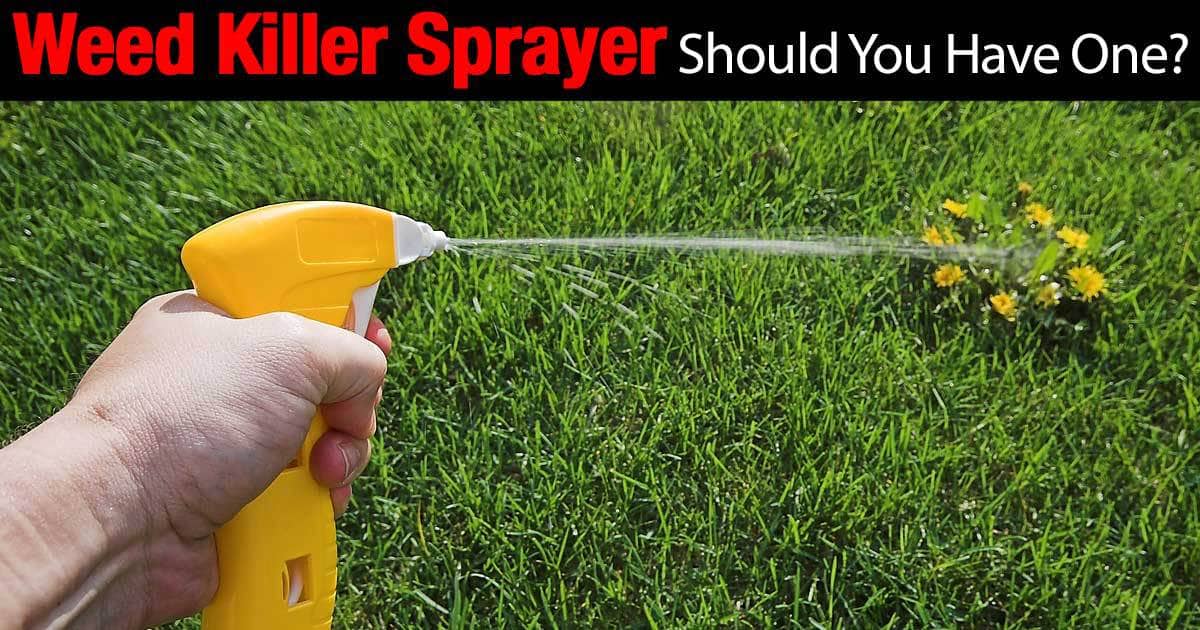Many homeowners wonder if they should have a weed sprayer like this one for weed control on the lawn, in landscape beds, along fence lines or in driveways and walkways.
The answer is YES – it’s a good idea to have an herbicide sprayer dedicated to weed killing ONLY!

You may ask Why?
Why have something else to store, maintain and spend money on. Why not have one garden sprayer for multiple uses.
One For Pest Control – One To Control Weeds
Herbicides, what we refer to as weed killers such as:
- 2,4-D (used as a Dandelion Killer)
- Glyphosate (Roundup) or this option
- Diquat dibromide (Eliminator)
- Other chemicals
These weed killing chemicals cannot be completely rinsed and removed from garden sprayers through any simple washing operation.
For this reason, alone, every gardener, landscaper, and DIY’er should have one garden sprayer for applying chemicals to control insects and diseases, and a separate weed sprayer plainly marked for applying weed killers (herbicides).
Only use the weed killer sprayer for weeds, since any trace of an herbicide left in the spray equipment may be enough to kill or severely damage vegetables and flowers.
Before we look at caring for a sprayer, let’s look at…
Selecting A Weed Sprayer
The process of selecting the best sprayer for killing weeds is no different than the selection process you would go through for picking out one for spraying insecticides.
Remember when applying herbicides, high pressure is not required. You just want to get the active ingredient on the weed. High pressure can atomize the spray solution allowing it to drift in the wind. Otherwise, it comes down to your needs.
For most homeowners, a simple 1-gallon tank sprayer made of “plastic” will serve their needs for small applications around the house.
Related: 8 Ways For Killing Weeds Naturally
A one-gallon pump sprayer should be sufficient for most homeowners to spot spray as needed. All garden sprayers come equipped with a spray wand, in-line filter, and a tip to adjust the spray pattern.
However, if your property is larger with a lot of fence line, driveway area and landscape beds, larger backpack sprayers with a 3 to 4-gallon tank may better suit your needs. The 4-gallon backpack being the most popular.
Related Reading: Backpack Sprayers: Your Guide To Sprayer Selection & Use
Backpack sprayers with their larger capacity mean less time is filling or refilling along with getting the job done faster.
The downside of Backpack Sprayers:
- Higher cost of spray equipment
- Weight hanging on your back
Take your time to review your needs and select the best sprayer for your job.
Look for these Sprayer Manufacturers:
Birchmeier | Chapin | Echo | Gilmour | Hudson | Solo | Lesco | Field King

Weed Sprayer Maintenance
A sprayer dedicated for weeds needs the same good care and attention given to other chemical garden sprayers, but it should be regarded strictly as a one-purpose tool.
Plant bugs, diseases, and weeds do not take vacations. So sprayer equipment needs to be always ready for use.
Modern sprayers for the lawn and garden receive a lot of use, abuse, and corrosive chemicals (insecticides and herbicides).
These chemicals, effective in controlling insects, diseases, and killing weeds can be very corrosive and damage tanks, hoses, and sprayer nozzles.
Prevent or reduce this corrosion and damage by washing out spraying equipment thoroughly after each use.
Sprayers last for many years with proper care.
Related Reading: Pesticide Spraying – Basic Principles Of Spray Safety
Maintenance & Care “Rules
- Follow manufacturer’s instructions regarding lubrication (don’t forget the pump handle), adjustment, operation and care
- Make it a rule to clean the sprayer after each use
- Drain out any residue or leftover solution
- Thoroughly flush the tank, hose lines and nozzles with clear water three times
- Disassembled nozzles, strainers and screens and wash, using a soft bristle brush or compressed air to remove any dirt or particles caught in the screens
- Before reassembling, pump clean water through the discharge system to flush out the hoses and nozzles and to remove any residues
- In reassembling, look for worn or defective sprayer parts and replace them immediately
The job of checking a sprayer is easy and should be done regularly.
Only Ordinary tools are required:
- Wrench for brass fittings
- Pliers for removing pins and clamps
- Screwdriver for removing and attaching hoses
- Soft cloth or sponge and soft bristle brush for cleaning
With the sprayer disassembled, clean and wash each part including hose, nozzle parts, and shutoff valves. Check each gasket to see that it is sound before it is put back into use.
Storing Sprayers For Winter
Before storing a sprayer for the winter season, pour some clean water into the tank and wash it thoroughly. Leave the tank open until all moisture evaporates. Once dried replace the top.
Sprayers treated in this manner will be ready for use in the spring. It is just as important to carefully wash out small hand pump sprayers to keep them free of corrosion as it is power sprayers.
Sprayers are not complicated equipment needing the attention of a trained mechanic. They do need the attention of a good caretaker.
With proper care, insecticide, herbicide weed spray equipment will continue to give excellent service for many years.
However, with careless handling, or misuse such as making it a storage tank for spray solutions, an important piece of equipment may be ruined in a single season.